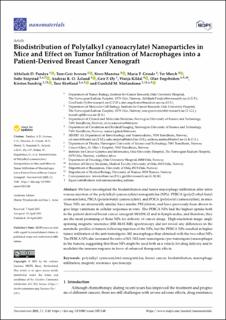| dc.contributor.author | Pandya, Abhilash D. | |
| dc.contributor.author | Iversen, Tore Geir | |
| dc.contributor.author | Moestue, Siver Andreas | |
| dc.contributor.author | Grinde, Maria Tunset | |
| dc.contributor.author | Mørch, Ýrr Asbjørg | |
| dc.contributor.author | Snipstad, Sofie | |
| dc.contributor.author | Åslund, Andreas | |
| dc.contributor.author | Øy, Geir Frode | |
| dc.contributor.author | Kildal, Wanja | |
| dc.contributor.author | Engebråten, Olav | |
| dc.contributor.author | Sandvig, Kirsten | |
| dc.contributor.author | Skotland, Tore | |
| dc.contributor.author | Mælandsmo, Gunhild Mari | |
| dc.date.accessioned | 2021-08-10T07:09:23Z | |
| dc.date.available | 2021-08-10T07:09:23Z | |
| dc.date.created | 2021-05-04T10:15:18Z | |
| dc.date.issued | 2021 | |
| dc.identifier.issn | 2079-4991 | |
| dc.identifier.uri | https://hdl.handle.net/11250/2767101 | |
| dc.description.abstract | We have investigated the biodistribution and tumor macrophage infiltration after intravenous injection of the poly(alkyl cyanoacrylate) nanoparticles (NPs): PEBCA (poly(2-ethyl-butyl cyanoacrylate), PBCA (poly(n-butyl cyanoacrylate), and POCA (poly(octyl cyanoacrylate), in mice. These NPs are structurally similar, have similar PEGylation, and have previously been shown to give large variations in cellular responses in vitro. The PEBCA NPs had the highest uptake both in the patient-derived breast cancer xenograft MAS98.12 and in lymph nodes, and therefore, they are the most promising of these NPs for delivery of cancer drugs. High-resolution magic angle spinning magnetic resonance (HR MAS MR) spectroscopy did not reveal any differences in the metabolic profiles of tumors following injection of the NPs, but the PEBCA NPs resulted in higher tumor infiltration of the anti-tumorigenic M1 macrophages than obtained with the two other NPs. The PEBCA NPs also increased the ratio of M1/M2 (anti-tumorigenic/pro-tumorigenic) macrophages in the tumors, suggesting that these NPs might be used both as a vehicle for drug delivery and to modulate the immune response in favor of enhanced therapeutic effects. | en_US |
| dc.language.iso | eng | en_US |
| dc.publisher | MDPI | en_US |
| dc.rights | Navngivelse 4.0 Internasjonal | * |
| dc.rights.uri | http://creativecommons.org/licenses/by/4.0/deed.no | * |
| dc.subject | magnetic resonance spectroscopy | en_US |
| dc.subject | macrophage infiltration | en_US |
| dc.subject | biodistribution | en_US |
| dc.subject | breast cancer | en_US |
| dc.subject | poly(alkyl cyanoacrylate) nanoparticles | en_US |
| dc.title | Biodistribution of Poly(alkyl cyanoacrylate) Nanoparticles in Mice and Effect on Tumor Infiltration of Macrophages into a Patient-Derived Breast Cancer Xenograft | en_US |
| dc.type | Peer reviewed | en_US |
| dc.type | Journal article | en_US |
| dc.description.version | publishedVersion | en_US |
| dc.rights.holder | Copyright: © 2021 by the authors. Licensee MDPI, Basel, Switzerland.This article is an open access article distributed under the terms and conditions of the Creative Commons Attribution (CC BY) license (https://creativecommons.org/licenses/by/4.0/). | en_US |
| dc.subject.nsi | VDP::Nanoteknologi: 630 | en_US |
| dc.subject.nsi | VDP::Nanotechnology: 630 | en_US |
| dc.subject.nsi | VDP::Nanoteknologi: 630 | en_US |
| dc.subject.nsi | VDP::Nanotechnology: 630 | en_US |
| dc.source.pagenumber | 14 | en_US |
| dc.source.volume | 11 | en_US |
| dc.source.journal | Nanomaterials | en_US |
| dc.source.issue | 5 | en_US |
| dc.identifier.doi | 10.3390/nano11051140 | |
| dc.identifier.cristin | 1907915 | |
| dc.source.articlenumber | 1140 | en_US |
| cristin.ispublished | true | |
| cristin.fulltext | original | |
| cristin.qualitycode | 1 | |

